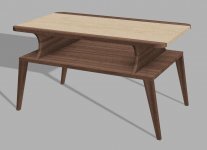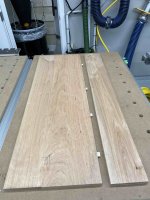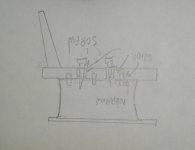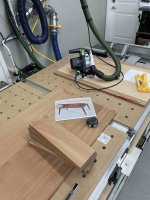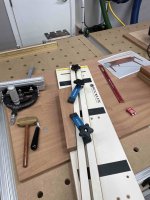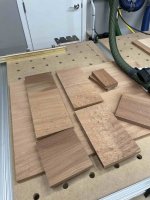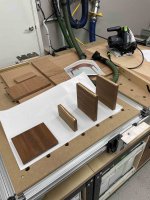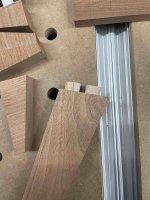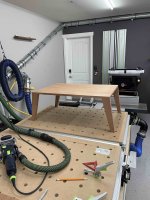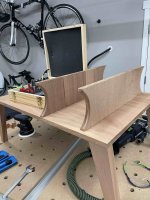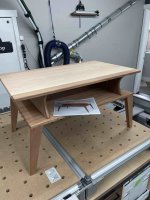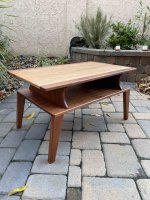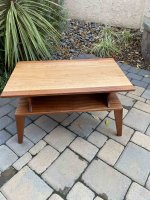mattbyington
Member
- Joined
- Mar 11, 2018
- Messages
- 797
OK team, a little modern coffee table the wife and I designed for a friend.
You guys would be proud of me. After all the feedback the last few months/years, this really is the first build that I'm actually thinking ahead on how the wood will move rather than gluing everything together like I normally do.
So here's the design, straight from Fusion 360.
Here are the challenges:
1) How to attach the top to the vertical curved "standoffs"
2) How to attach the bottom to the vertical curved standoffs
I feel like for (1), z clips, figure 8 fasteners, or wooden buttons with a mortise would all work fine - so I feel like that's not too hard.
However for (2), you can't do that since it'll be seen obviously. One idea I had was to drill holes for dominos with the domino as if I were going to glue them together, but make these holes go all the way through.
Then, use screws from underneath the bottom up through the domino holes in the bottom into the edge grain (pilot hole) of the vertical parts. That way as the bottom expands and contracts, the screws can move within the domino slots.
Any better ideas? (Or is that idea even a good one?)
Thanks so much in advance. Using Sapele and Cherry.
Matt
[attachimg=1]
[attachimg=2]
[attachimg=3]
You guys would be proud of me. After all the feedback the last few months/years, this really is the first build that I'm actually thinking ahead on how the wood will move rather than gluing everything together like I normally do.
So here's the design, straight from Fusion 360.
Here are the challenges:
1) How to attach the top to the vertical curved "standoffs"
2) How to attach the bottom to the vertical curved standoffs
I feel like for (1), z clips, figure 8 fasteners, or wooden buttons with a mortise would all work fine - so I feel like that's not too hard.
However for (2), you can't do that since it'll be seen obviously. One idea I had was to drill holes for dominos with the domino as if I were going to glue them together, but make these holes go all the way through.
Then, use screws from underneath the bottom up through the domino holes in the bottom into the edge grain (pilot hole) of the vertical parts. That way as the bottom expands and contracts, the screws can move within the domino slots.
Any better ideas? (Or is that idea even a good one?)
Thanks so much in advance. Using Sapele and Cherry.
Matt
[attachimg=1]
[attachimg=2]
[attachimg=3]

